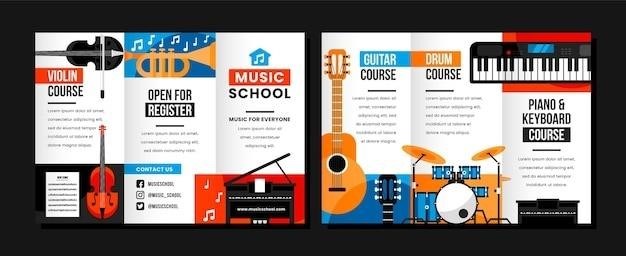the musician’s guide workbook fourth edition answers pdf

the musician’s guide workbook fourth edition answers pdf
The Musicians Guide Workbook (Fourth Edition)⁚ An Overview
This workbook supplements the fourth edition of “The Musicians Guide to Theory and Analysis,” providing exercises to reinforce core musical concepts. It features a wide range of drills and practice activities.
The Workbook’s Purpose and Content
The “Musicians Guide Workbook (Fourth Edition)” aims to solidify the theoretical knowledge gained from its accompanying textbook, “The Musicians Guide to Theory and Analysis (Fourth Edition).” Its content directly correlates with the textbook, offering practical application of learned concepts. The workbook includes a diverse array of exercises, encompassing various aspects of music theory such as harmony, counterpoint, rhythm, and musical form. These exercises range in difficulty, catering to students of all skill levels, from introductory to advanced. The exercises are designed to be comprehensive, challenging students to apply their theoretical understanding to practical musical scenarios. The goal is to build a solid foundation in music theory through consistent practice and application.
Exercises and Practice Activities
The Musicians Guide Workbook (Fourth Edition) is packed with a variety of exercises designed to reinforce the concepts presented in the accompanying textbook. These activities go beyond simple rote learning, encouraging active engagement with musical theory. Expect to find a mix of drill-and-practice exercises to solidify fundamental concepts, part-writing exercises to develop compositional skills, and analytical exercises to hone critical listening and interpretive abilities. The exercises are thoughtfully structured to progressively increase in complexity, allowing students to build a strong foundation and gradually tackle more challenging musical tasks. This structured approach ensures a comprehensive learning experience, fostering a deeper understanding of music theory through practical application and problem-solving.
Target Skill Levels
The Musicians Guide Workbook (Fourth Edition) caters to a broad range of skill levels within music theory. From fundamental concepts like basic rhythm and melodic dictation to more advanced topics such as advanced harmony and complex analysis, the exercises are carefully graded to accommodate diverse learning needs. Beginners will find ample opportunities to build a strong foundational understanding, while more experienced students will be challenged with complex exercises requiring critical thinking and problem-solving. The comprehensive nature of the workbook ensures that students at all levels can find appropriate exercises to enhance their musical skills and knowledge. This adaptability makes it a valuable resource throughout a student’s musical journey, providing ongoing support and challenges.
Locating the Answer Key
Official answer keys may be available through the publisher or instructors. Third-party resources might offer solutions, but verify their accuracy.
Availability of Official Answer Keys
The availability of official answer keys for the “Musicians Guide Workbook (Fourth Edition)” varies. Some sources suggest that an instructor’s edition, containing the answers, exists, implying that access might be restricted to educators and not publicly available for purchase. Other online discussions mention the possibility of finding answer keys through the publisher’s website or by contacting them directly. However, there is no definitive confirmation of a readily accessible, standalone answer key for students. The lack of widespread availability online suggests that the publisher intends for the answers to be used primarily within a classroom setting, guided by an instructor.
Teacher Editions and Instructor Resources
Instructors utilizing “The Musicians Guide Workbook (Fourth Edition)” often have access to supplementary resources not available to the general public. These resources frequently include comprehensive answer keys, detailed solutions for complex exercises, and potentially additional teaching materials designed to facilitate classroom instruction. These teacher editions are typically purchased separately from the student workbook and may be bundled with the accompanying textbook, “The Musicians Guide to Theory and Analysis.” Access to these instructor-specific resources is usually restricted to verified educators or educational institutions, ensuring that the integrity of the learning process remains intact.
Third-Party Resources and Solutions
While official answer keys might be limited to instructors, various unofficial resources may offer solutions for the “Musicians Guide Workbook (Fourth Edition).” These could include online forums, student-created solution manuals, or websites dedicated to providing answers to educational materials. However, exercise caution when using these third-party resources. The accuracy and reliability of such answers are not guaranteed, and using them without careful verification could hinder genuine learning. Always prioritize understanding the underlying concepts over simply obtaining correct answers. Relying solely on unverified solutions could negatively impact your grasp of the subject matter.

Finding Answers Online
Searching online for solutions to the Musicians Guide Workbook can yield varied results. Use caution; verify information from multiple reliable sources.
Searching for Solutions on the Internet
Finding answers online for the “Musicians Guide Workbook, Fourth Edition” requires a strategic approach. Begin by using precise search terms, such as “Musicians Guide Workbook 4th edition solutions,” or even more specific phrases targeting particular chapters or exercise types. Explore reputable educational websites and forums; these often offer student-submitted solutions or discussions. Be wary of sites offering complete answer keys as PDFs, as these may be unreliable or contain errors. Always cross-reference any information found online with your own understanding of the concepts. Remember that understanding the underlying musical principles is key to mastering the material, not just obtaining the correct answers. The internet can be a helpful tool, but critical evaluation of the information found is essential. Focus on using online resources to clarify doubts, not to simply copy solutions.
Utilizing Online Forums and Communities
Online music theory forums and communities can be invaluable resources when tackling the “Musicians Guide Workbook, Fourth Edition.” Sites like Reddit or dedicated music theory forums often have threads dedicated to specific textbooks and workbooks. Searching these forums for discussions related to the workbook can reveal helpful hints, alternative solutions, and explanations of challenging concepts. Engaging with other students and experienced musicians can provide different perspectives and insights. Remember to always contribute positively to the community by sharing your own understanding and asking respectful questions. However, be mindful of the potential for inaccurate information; always verify any answers received through these channels by cross-referencing them with the textbook or other reliable sources. Actively participating in these forums fosters a collaborative learning environment and can significantly enhance your understanding of the material.
Caution Regarding Unverified Answers
While online resources can be helpful, relying solely on unverified answers from websites or forums for the “Musicians Guide Workbook, Fourth Edition” is strongly discouraged. Many online solutions may contain errors, incomplete explanations, or even completely incorrect information. Blindly copying these answers hinders the learning process and prevents you from developing a true understanding of the underlying musical concepts. The goal of the workbook is to build your skills and understanding, not just to obtain correct answers. Therefore, it’s crucial to prioritize independent problem-solving and critical thinking. Use online resources as supplementary aids, but always double-check any information found online against the textbook or other reputable sources. Focusing on understanding the why behind the answers is more valuable in the long run than simply finding the correct solution.

The Associated Textbook
The workbook directly complements “The Musicians Guide to Theory and Analysis (Fourth Edition),” by Clendinning and Marvin, enhancing its learning objectives.
The Musicians Guide to Theory and Analysis (Fourth Edition)
The Musicians Guide to Theory and Analysis, Fourth Edition, serves as the foundational textbook for the accompanying workbook. Authored by Jane Piper Clendinning and Elizabeth West Marvin, this widely-used text covers fundamental music theory concepts. These include harmony, counterpoint, rhythm, and form, providing a comprehensive theoretical framework for aspiring musicians. The textbook’s clear explanations and numerous examples make complex musical ideas accessible to students of various skill levels. Its popularity stems from its effective blend of theoretical rigor and practical application, making it a valuable resource for both classroom instruction and self-study. The Fourth Edition likely incorporates updates and refinements to the content, reflecting advancements in music theory pedagogy and current best practices. Its comprehensive approach makes it a cornerstone text in many music theory curricula.
Relationship Between Textbook and Workbook
The workbook acts as a direct companion to the textbook, designed to reinforce the concepts and skills introduced within “The Musicians Guide to Theory and Analysis, Fourth Edition”. Each exercise in the workbook directly correlates to specific chapters or sections in the textbook, allowing for targeted practice and skill development. The workbook’s structure mirrors the textbook’s progression, ensuring a cohesive learning experience. Students are encouraged to consult the textbook for clarification on any theoretical concepts before attempting the workbook exercises. This integrated approach enhances understanding and retention of the material, enabling students to actively apply their theoretical knowledge in a practical setting. The exercises range in difficulty, providing opportunities for both reinforcement and challenge.
Authors and Publishers
The “Musicians Guide to Theory and Analysis Workbook, Fourth Edition,” shares authorship with its accompanying textbook. Jane Piper Clendinning and Elizabeth West Marvin are credited as the authors of both the textbook and its corresponding workbook. This consistent authorship ensures a unified approach to the presentation of musical theory concepts and their application within the exercises. The publisher of both the textbook and the workbook is W. W. Norton & Company, a well-established academic publisher known for its high-quality educational materials. This consistent publishing ensures a cohesive presentation across both resources, benefiting students in their learning journey. The publisher’s reputation assures a degree of quality control and accessibility in the materials.